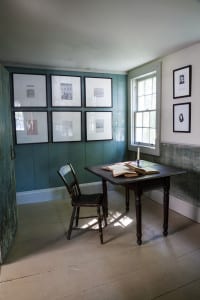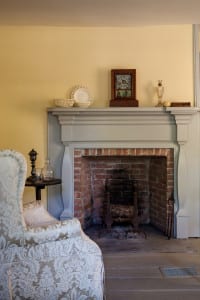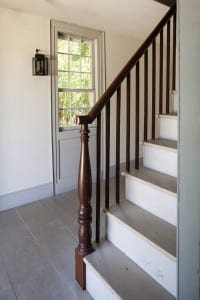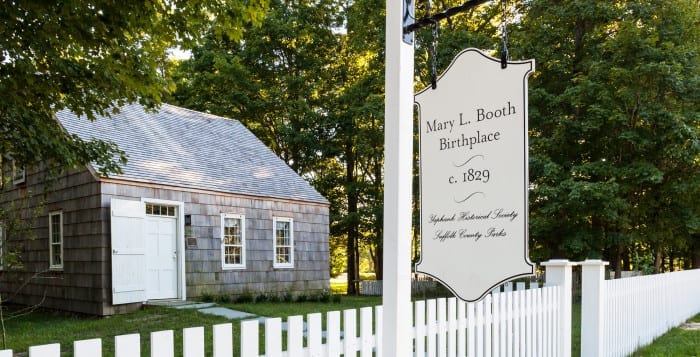By Rita J. Egan
On Jan. 27, the childhood home of a writer, editor and translator of the 1800s, Mary Louise Booth, was officially listed on the National Register of Historical Places. Members of the Yaphank Historical Society were anticipating the news since the New York State Board for Historic Preservation approved the house for submission in the beginning of December.

Tricia Foley, historian for the Yaphank Historical Society who is working on a book about Booth, said the house, located at the intersection of E. Main Street and Yaphank Avenue, was built in 1829.
“It’s an early house of the period at the beginning of Yaphank’s development. In 1800 there were only 20 houses here and by the 1840s there were 200,” she said.
Foley said the Long Island ½-house is a one-story structure with an attic, two windows in the front and a door on the left. This was so if the owners added an extension, the door could be in the middle, according to the historian. Foley said many of the ½-houses were custom built, and the Booth house features beaded edges around all the windows as well as fireplace mantles in the parlor and bedroom with an unusual detailed, carving style.
Its inclusion on the list means the historical society can apply for more grants and there’s increased protection against demolition in the future, according to Foley. The group hopes to apply for a grant in the near future for renovation.
“There is a bay window in the kitchen, in the keeping room, and when we get more funding we would like to remove it, because it’s not period appropriate. It was probably put on later in the 19th century or early 20th century,” the historian said.
An exhibit documenting Booth’s life, who was born in 1831, is on display at the house. The Yaphank native was one of the first female reporters for The New York Times and the author of “History of the City of New York.” Foley said this book was originally intended to be a school textbook, but once the publisher realized just how significant the work was, it was released for public distribution.

Booth was also the founding editor of Harper’s Bazaar when the magazine started as a weekly in 1867 and worked with the publication for 22 years until her death in 1889, according to Foley. The historian said the editor did her best to educate women about the pressing subjects of the era.
“She was a suffragist and abolitionist, and she quietly brought in women’s issues into the different features and columns every week to keep women apprised of what was happening. She didn’t express her opinions, but she let people know very quietly,” she said.
While Booth remained objective when it came to the articles she published, outside her office, the editor and her friend Susan B. Anthony were involved in working toward equal pay for teachers. The former Yaphank resident was also part of the Women’s Suffrage movement, and she was the secretary of the 1855 Women’s Rights Convention in Saratoga Springs. The writer and editor was considered an abolitionist as well, and during her research, Foley found that Abraham Lincoln sent Booth a letter for her efforts in the Union cause. The president was impressed by the writer’s personal work as well as inspired by a book she translated from French to English called “Uprising of a Great People” by Count Agénor de Gasparin.
Foley said Booth, who during her lifetime translated over 40 books from French to English, was also involved in the Statue of Liberty transaction due to her translating and networking abilities. The translator introduced the statue’s sculpture, Frédéric Auguste Bartholdi, to key players in New York City such as bankers and government officials. The historian said Booth showed a gift for language at a young age. After she and her family moved from Yaphank to Williamsburg, Brooklyn, when she was 14 years old, the future translator taught Latin classes as a teenager and also attended a French academy to practice conversational French.

“She had such a gift for language. She picked up conversational French very easily,” Foley said.
The historian said she isn’t surprised that Booth’s childhood home, which is the last remaining residence of her lifetime, was recognized on the register considering her work, which influenced the country and New York State history. The house, which was originally located on E. Main Street across from where it stands today, had various owners throughout the years until it became the property of the Kinney family after World War II. When the family donated the house to Suffolk County Historic Services in 1998, it was moved to its current location, and the Yaphank Historical Society became the steward of the home, according to Foley.
The public can visit the Mary Louise Booth Childhood Home Sunday afternoons in July and August or by appointment. For more information, visit www.yaphankhistorical.org or call 924-3401.





